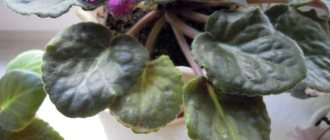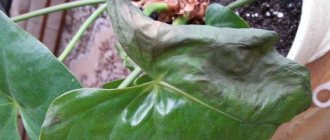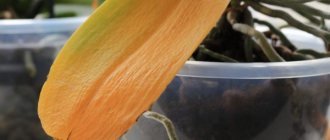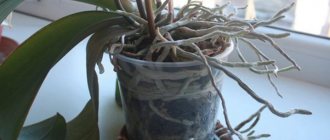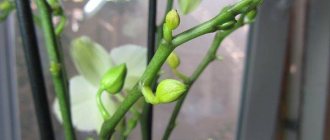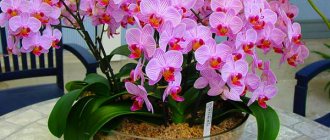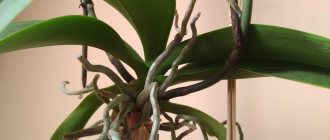Orchid Dendrobium (Dendrobium nobile) is one of the cutest and noblest representatives of its species, but at the same time the most fastidious. But meticulous care of the flower is not so bad. Dendrobium, like other houseplants, is susceptible to a number of diseases and pests. Even growing in ideal conditions does not guarantee the absence of problems in this regard.
We will try to find out what causes Dendrobium nobile, consider the causes of pathologies and treatment options. Let's also mention common pests, which are also the source of most problems.
What diseases are detected in the presence of black spots and dots on orchid leaves?
Why did these symptoms appear in the plant? The cause of most orchid diseases, which are non-infectious in nature, can be safely considered to be inappropriate conditions of detention . In addition, poor care weakens the plant, causing the appearance of phytopathogens:
- Microscopic fungi. Causes damage to leaves and stems. A likely factor is low cultivation temperatures coupled with high humidity.
- Bacteria. More often they develop when any part of the orchid is injured or cause rotting due to stagnation of moisture.
- Viral diseases. Associated with the physiological characteristics of the plant.
To restore the health of an orchid, first of all, it is necessary to find out the cause of the disease and know how to eliminate it.
Reproduction
Children
In Dendrobium Nobile, reproduction occurs in three ways. One of them is through the so-called “children”. Newly grown shoots can be transplanted when their roots become five centimeters. The baby is cut off from an adult shoot with a well-sharpened blade. The “wound” is sprinkled with coal. After holding it in the air for a while, it is planted in the ground in a simple way, as when transplanting. Organize a greenhouse effect by covering it with any container or bag. Flowering can be expected within a year.
Cuttings
Sometimes the question arises of what to do with Dendrobium Nobile after flowering and what to do with the old stem. The solution is propagation by cuttings. This is a fairly simple method that almost always gives a positive result.
The pseudobulb is cut off with a sharp knife near the roots. Next, it is cut into pieces approximately 10 cm long. The main thing is that there are 2-3 buds on each cutting. Wet sphagnum is placed in the container, which will serve as a medium for germination. The cuttings are placed horizontally in it. The jar is closed with a lid to create a greenhouse effect. It must be opened for 5 minutes every day. Leave the orchid to germinate in a well-lit and warm room (within 22 degrees). After 15-20 days you will be able to notice the roots. When they get stronger and become larger, they are sent to new pots with soil.
Bulbs
A young pseudobulb that has not yet produced flowers is cut off. As in the previous version, it is placed in a closed container filled with sphagnum. After about a month, new shoots should appear. When the roots of the shoots reach 5 cm, they can be replanted. This method of propagating Dendrobium Nobile takes longer, but allows you to get several young plants at once.
Errors in care as a reason
Often the occurrence of orchid disease is explained by improper care .
Sun or heat burns.
Such damage to orchid leaves most often occurs due to:
- exposure to direct sunlight ;
- heat from heating radiators in winter;
- flow of hot air from the air conditioner.
This orchid condition is not a disease and therefore cannot be treated.
Insufficient lighting, low temperature, waterlogging.
A complex of unfavorable factors provoke yellowing and wilting of leaves , as well as blackening of the leaf blade due to:
- excess moisture as a result of frequent watering;
- insufficient or weak lighting ;
- hypothermia of the flower.
With short-term freezing, the orchid still has a chance to survive, but if it spent more than 11 hours in the cold , it will most likely die.
How to normalize care?
The conditions for keeping the flower are as close to natural as possible, alternating abundant watering with warm water and drying out the substrate. Good soil drying is ensured by:
- free air circulation ;
- regular ventilation .
In the room where the orchids are located, drafts must be excluded .
When determining the frequency and abundance of watering, take into account:
- pot volume;
- room temperature;
- substrate density.
Attention! The watering regime for orchids is set based on the condition of the soil in the pot, and not on the period of time after which watering is carried out.
An orchid that has black spots due to improper care is rearranged:
- to diffuse sunlight . In the autumn-winter period, additional lighting may be needed;
- summer daytime air temperature in the apartment should be from 15 to 30℃ , in winter – 20-23℃ . Daily fluctuations in day and night temperatures are within 3-5 ℃;
- The ambient humidity is at least 50 , and for some types of orchids (Vanda) - more than 60%.
In favorable conditions, the flower will be able to recover as quickly as possible.
Features of Dendrobium transplantation
Dendrobiums are transplanted no more often than once every two to four years, since they do not like this procedure. You need a good reason for this, such as:
- pieces of bark in the substrate turned into dust;
- the root system has filled the entire planting container, displacing the substrate, and now it is clearly not enough to support the plant;
- roots stick out above the surface of the substrate;
- due to the tightness of the pot, the flower stopped growing;
- a coating of salty soil appeared on the roots.
This may be interesting: Cattleya - orchid care at home
Dendrobium should be replanted in the spring, when the plant is just emerging from dormancy and is preparing for active growth. We do not recommend replanting during flowering. But, if there is a suspicion of rotting of the root system, there is no need to wait for favorable conditions, urgently start replanting.
Soil for replanting
A special substrate for Dendrobium is prepared or purchased, different from the substrate for other indoor flowers. It is more loose, lightweight, moisture-permeable and breathable. It consists of large pieces (1-3 cm) of pine bark (2 hours), large expanded clay (1 hour), charcoal (1 hour). Sometimes, pieces of sphagnum moss are added here. But not much, so that excess moisture does not cause rotting of the roots. The substrate performs more of a function of fixing the roots than feeding the flower. Expanded clay and coal accumulate moisture during watering, and then gradually release it to the bark. Coal is also needed to prevent fungal diseases and fight mold that may appear in pieces of pine bark. If you prepare the substrate yourself, take the time to disinfect all components of the soil mixture. Boil the bark a couple of times, then dry it well. If you buy a ready-made substrate for epiphytic or orchids, you will not go wrong.
Pot for Dendrobium
Prepare a ceramic or plastic pot for transplanting Dendrobium, slightly larger than the root ball. Not necessarily transparent - these are needed only for Phalaenopsis. Dendrobiums in transparent pots have roots that overheat. Be sure to lay a good drainage layer at the bottom of the pot from the largest pieces of bark or expanded clay.
Dendrobium orchid transplant process
Now proceed to transplanting the plant itself.
Remove it from the pot. Free the roots from the substrate and inspect them. Trim those that are damaged, rotten or too long. Sprinkle the cuts with crushed coal. Let them dry a little. After this, place the bush in a new pot on a layer of drainage. Cover the roots with substrate so that there are no voids between the roots. Water it. It is advisable that two to three cm from the top of the pot to the base of the rosette remain free. Then, as the aerial roots grow, there will be room in the pot to add substrate. A large specimen of the Dendrobium orchid with fleshy, heavy leaves needs to be strengthened in the substrate. During replanting, we recommend installing a support in the pot and immediately tying the flower to it so that it does not wobble.
After transplantation, it will take a couple of weeks until the flower regains its strength. At this time he needs help. Place the pot in a bright, warm place with high humidity, but in partial shade. If the interference in the root system of the plant was noticeable, we recommend placing the transplanted plant in a large plastic bag to create a greenhouse effect - it will be easier for Dendrobium to recover. For a couple of weeks. Look into the bag and ventilate it if necessary. If the flower looks strong and cheerful, take it out of the bag and put it in its rightful place - let it grow with renewed vigor.
Plant diseases as the cause of the problem
A weakened plant is easily susceptible to various diseases.
Fungal diseases
Successful treatment of orchids is impossible without identifying the causative agent of the disease. Among the fungal phytopathogens, the most common are:
- Anthracosis. The disease is favored by conditions of excess humidity and water stagnation in leaf axils. It manifests itself in a rapid increase in black spots on the leaves already at the initial stages, individual dark spots gradually merge into spots;
- Phyllosticosis . The disease appears as yellow and black dots on the leaves , the size of which remains constant for 2-3 months. During this latent period, the fungus rapidly develops inside the tissues. The disease affects the entire leaf blade and causes its death;
- Late blight . The most dangerous fungal disease of orchids. Characterized by the appearance of purple spots , which then spread, turn black and can cause the death of the plant. Black sunken spots often appear where the leaf meets the stem, and the affected area crumbles, leaving a black mesh.
The disease occurs due to excessive watering or high soil density.
Treatment of fungal diseases involves immediate removal of stains with a sterile instrument , disinfection of sections, and treatment of the entire plant with a fungicide. Then the orchid is moved to diffused light in a well-ventilated place.
Viral diseases
Orchids are rarely affected by viruses . The disease most often manifests itself on leaves as mosaic spotting .
The nature of the disease is influenced by the structure of the leaves (thickness, fleshiness). of small light spots in the initial phase is typical ; over time, they darken and are pressed through. Sometimes the middle of the black ring remains green. Affected plants are destroyed.
Bacterial lesions
The most common bacterial diseases of orchids are:
- bacterial rot. It appears as brown spots on the leaf blades; over time they grow and darken. The disease spreads to the remaining parts of the plant until it completely captures them;
- bacterial spot. A characteristic feature is dark spots framed by a light rim.
In the initial phase of the disease, all spots are carefully cut out along with part of the healthy tissue . If the lesion covers a large area of the leaf, it is completely removed. Sections are disinfected with brilliant green or iodine. After the procedure, watering the orchid should be moderate.
Thrips
These are small insects up to 2.5 mm in size. The activity of the pest has an extremely negative effect on all types of orchids and Dendrobium in particular. The insect has a pair of wings that fold on the back and is characterized by increased activity: it moves quickly and hides skillfully.
As soon as the pest hits the flower, it tries to hide in the ground. To detect the presence of thrips visually, you have to watch the plant at night with a flashlight. If you suddenly turn on the light, the insect will immediately reveal itself. Indirect indicators of the presence of the parasite are a silvery film and black dots on the greenery.
The consequences of prolonged stay of thrips on the orchid are numerous brown spots. This indicates the appearance of larvae and that you need to start fighting the parasite immediately.
The difficulty in controlling thrips lies in its persistence. They lay tiny and well-protected eggs in leaf tissue. After the larvae hatch, they feed on these greens, moving from place to place.
The pest subsequently affects not only the foliage, but also affects the root system, which leads to the death of the flower.
What to do if black spots appear at the base of the leaf?
Most often, their occurrence is associated with infection of the plant by phytopathogens , and not due to ordinary rotting from stagnant water:
- to prevent the spread of the disease, the damaged area is removed , partially capturing healthy green tissue;
- sections are disinfected with iodine , brilliant green, and crushed charcoal.
To eliminate stagnant water that accumulates in the axils of the leaves after watering, remove it with a paper napkin .
If the tips of the leaves begin to turn black?
To stop the spread of the disease:
- if possible, establish the nature of the disease ;
- blackened areas are trimmed with sterile scissors ;
- provide optimal care and maintenance of the orchid.
If the disease is infectious, the plant is isolated and, if necessary, treated with a fungicide.
Shchitovka
This parasite looks like the tip of a match head and lives on leaves and pseudobulbs. The size of scale insects varies around 0.2 cm. The pest attaches itself tightly and for a long time to the chosen place and leaves it with great reluctance.
The scale insect feeds on plant sap and, when processing it, produces a viscous liquid. By this sign it is possible to determine the presence of a parasite on a flower. Small clusters of dark spots appear on the leaves. But even upon visual inspection, the pest itself is clearly visible on the orchid.


